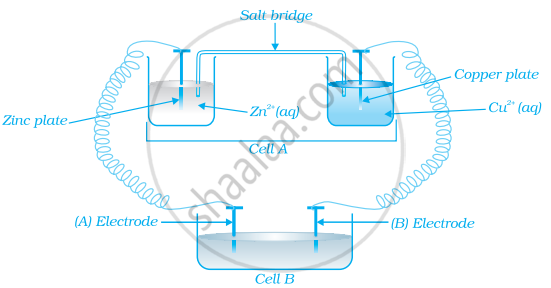Advertisements
Advertisements
Question
Can copper sulphate solution be stored in an iron vessel? Explain.
Solution
Higher the standard reduction potential (Eº) value, greater the tendency of the species to accept electrons and undergo reduction.
Cu2++2e-→Cu, Eº = + 0.337 V ; Fe2+ + 2e- → Fe, Eº = - 0.440 V
Therefore, Cu2+ has a greater tendency to undergo reduction than Fe2+ or Fe can reduce (or displace) Cu2+ ions from its salt solution.
Fe(s) +Cu2(aq) → Fe2(aq) + Cu(s)
Hence, copper sulphate solution cannot be stored in an iron vessel as the iron vessel dissolves forming Fe2+ ions and Cu2+ ions from copper sulphate solution forms Cu.
APPEARS IN
RELATED QUESTIONS
Draw a neat and well labelled diagram of primary reference electrode.
The standard e.m.f of the following cell is 0.463 V
`Cu|Cu_(1m)^(++)`
What is the standard potential of Cu electrode?
(A) 1.137 V
(B) 0.337 V
(C) 0.463 V
(D) - 0.463 V
Calculate E°cell for the following reaction at 298 K:
2Al(s) + 3Cu+2(0.01M) → 2Al+3(0.01M) + 3Cu(s)
Given: Ecell = 1.98V
Calculate emf of the following cell at 25°C:
\[\ce{Sn/Sn^2+ (0.001 M) || H+ (0.01 M) | H2_{(g)} (1 bar) | Pt_{(s)}}\]
Given: \[\ce{E^\circ(Sn^2+/sn) = -0.14 V, E^\circ H+/H2 = 0.00 V (log 10 = 1)}\]
Calculate e.m.f of the following cell at 298 K:
2Cr(s) + 3Fe2+ (0.1M) → 2Cr3+ (0.01M) + 3 Fe(s)
Given: E°(Cr3+ | Cr) = – 0.74 VE° (Fe2+ | Fe) = – 0.44 V
Calculate e.m.f. and ∆G for the following cell:
Mg (s) |Mg2+ (0.001M) || Cu2+ (0.0001M) | Cu (s)
`"Given :" E_((Mg^(2+)"/"Mg))^0=−2.37 V, E_((Cu^(2+)"/"Cu))^0=+0.34 V.`
Given the standard electrode potentials,
\[\ce{K+/K}\] = −2.93 V, \[\ce{Ag+/Ag}\] = 0.80 V,
\[\ce{Hg^{2+}/Hg}\] = 0.79 V
\[\ce{Mg^{2+}/Mg}\] = −2.37 V, \[\ce{Cr^{3+}/Cr}\] = −0.74 V
Arrange these metals in their increasing order of reducing power.
Depict the galvanic cell in which the reaction \[\ce{Zn(s) + 2Ag+(aq) → Zn^{2+}(aq) + 2Ag(s)}\] takes place. Further show:
- Which of the electrode is negatively charged?
- The carriers of the current in the cell.
- Individual reaction at each electrode.
Calculate the emf of the following cell at 25°C :
Galvanic or a voltaic cell converts the chemical energy liberated during a redox reaction to ____________.
Which cell will measure standard electrode potential of copper electrode?
The difference between the electrode potentials of two electrodes when no current is drawn through the cell is called ______.
Using the data given below find out the strongest reducing agent.
`"E"_("Cr"_2"O"_7^(2-)//"Cr"^(3+))^⊖` = 1.33 V `"E"_("Cl"_2//"Cl"^-) = 1.36` V
`"E"_("MnO"_4^-//"Mn"^(2+))` = 1.51 V `"E"_("Cr"^(3+)//"Cr")` = - 0.74 V
Value of standard electrode potential for the oxidation of \[\ce{Cl-}\] ions is more positive than that of water, even then in the electrolysis of aqueous sodium chloride, why is \[\ce{Cl-}\] oxidised at anode instead of water?
Assertion: Cu is less reactive than hydrogen.
Reason: `E_((Cu^(2+))/(Cu))^Θ` is negative.
Consider the figure and answer the following question.
If cell ‘A’ has ECell = 0.5V and cell ‘B’ has ECell = 1.1V then what will be the reactions at anode and cathode?
Represent the cell in which the following reaction takes place.The value of E˚ for the cell is 1.260 V. What is the value of Ecell?
\[\ce{2Al (s) + 3Cd^{2+} (0.1M) -> 3Cd (s) + 2Al^{3+} (0.01M)}\]
The standard electrode potential of the two half cells are given below:
\[\ce{Ni^{2+} + 2e^{-} -> Ni, E_0 = - 0.25 Volt}\]
\[\ce{Zn^{2+} + 2e^{-} -> Zn, E_0 = - 0.77 Volt}\]
The voltage of cell formed by combining the two half cells would be?
Which is the correct order of second ionization potential of C, N, O and F in the following?
Standard electrode potential of three metals X, Y and Z are – 1.2 V, + 0.5 V and – 3.0 V, respectively. The reducing power of these metals will be:
The potential of a hydrogen electrode at PH = 10 is
